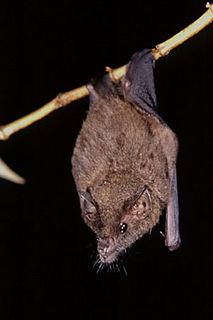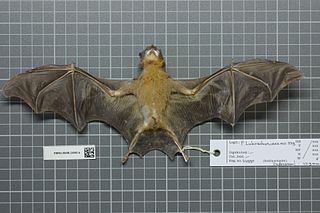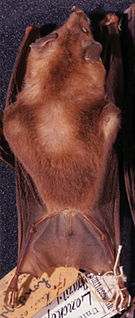
The New World leaf-nosed bats (Phyllostomidae) are found from southern North America to South America, specifically from the Southwest United States to northern Argentina. They are ecologically the most varied and diverse family within the order Chiroptera. Most species are insectivorous, but the phyllostomid bats include within their number true predatory species and frugivores. For example, the spectral bat, the largest bat in the Americas, eats vertebrate prey, including small, dove-sized birds. Members of this family have evolved to use food groups such as fruit, nectar, pollen, insects, frogs, other bats, and small vertebrates, and in the case of the vampire bats, even blood.

Spix’s disk-winged bat, is a species of bat in the family Thyropteridae. It is native to the Americas from Mexico to Brazil. The most prominent anatomical feature of this bat, which distinguishes it from other species, is the disks on its thumbs and hind feet. These circular disks act as suction cups, allowing the bats to cling onto and move along smooth surfaces.

Geoffroy's tailless bat is a species of phyllostomid bat from the American tropics.

Pallas's long-tongued bat is a South and Central American bat with a fast metabolism that feeds on nectar.

The yellow-throated big-eared bat or orange-throated bat(Lampronycteris brachyotis) is a species of bat that ranges from southern Mexico to Brazil. It is the only species within the genus Lampronycteris. A frugivore and insectivore, it is found in lowland forest up to an elevation of 700 m. Its activity is greatest in the first two hours after sunset, and peaks again after midnight.

The dark long-tongued bat is a species of bat from South and Central America. It was formerly considered the only species within the genus Lichonycteris, but is now recognized as one of two species in that genus, along with the pale brown long-nosed bat. It is small species of bat, with adults weighing 6–11 g (0.21–0.39 oz) and having a total length of 46–63 mm (1.8–2.5 in).

Bokermann's nectar bat is a bat species from South America. It is endemic to Brazil. It feeds on nectar, and is listed as an endangered species.

Dekeyser's nectar bat is a bat species found in Brazil and Bolivia.

Goldman's nectar bat is a bat species found in Brazil, Colombia, Costa Rica, Ecuador and Panama.

Thomas's nectar bat is a bat species from South and Central America. Thomas's nectar bat pollinates the vine Marcgravia.

Lonchophylla is a genus of bats in the family Phyllostomidae.

The gray short-tailed bat, or Hahn's short-tailed bat, is a species of bat in the family Phyllostomidae native to Mexico and Central America.

The Mexican long-tongued bat is a species of bat in the family Phyllostomidae. It is the only species within the genus Choeronycteris. The species is found in El Salvador, Guatemala, Honduras, Mexico, and the United States.

The black-bellied fruit bat is a species of order bat in the family Pteropodidae.

Leach's single leaf bat, also known as Greater Antillean long-tongued bat, is a species of bat in the family Phyllostomidae. It is found in the southern Bahamas and in all the Greater Antilles. It forms large colonies, with up to a few hundred thousand individuals, and feeds on a relatively wide variety of food items including pollen, nectar, fruit and insects.

The banana bat is an endangered species of bat in the family Phyllostomidae. It is also commonly known as the trumpet-nosed bat or the Colima long-nosed bat.

Glossophaginae is a subfamily of leaf-nosed bats.

Peracchi's nectar bat is a species of nectar-feeding bat in the family Phyllostomidae. It was first described from the Atlantic Forest in southeastern Brazil.
Lonchophylla orienticollina is a species of bat found in Colombia, Venezuela, and Ecuador.



















